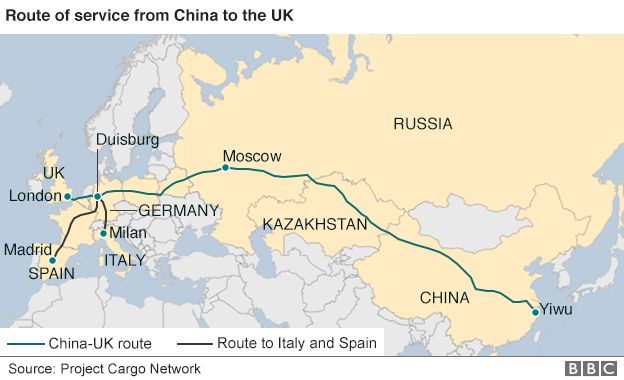The first direct rail freight service from China to the UK has completed its 18-day trip and arrived in London.
The train left the city of Yiwu, on China's east coast, this month and travelled 7,500 miles (12,000km), crossing seven countries, before arriving at a freight depot in Barking.
The service delivered 34 containers of clothes and high street goods.
China Railway already runs services between China and other European cities, including Madrid and Hamburg.
The service passed through Kazakhstan, Russia, Belarus, Poland, Germany, Belgium and France before entering the UK via the Channel Tunnel.

In order to make the journey, a number of different locomotives and wagons were used as the railways of the former Soviet Union states have a larger rail gauge.
However, the rail firms say the service is still cheaper than air freight and faster than sending goods by sea.
The service is part of China's One Belt, One Road programme - reviving the ancient Silk Road trading routes to the West.
The Silk Road was an ancient network of trade routes, formally established during the Han Dynasty of China, which linked the regions of the ancient world in commerce between 130 BCE-1453 CE. As the Silk Road was not a single thoroughfare from east to west, the term 'Silk Routes’ has become increasingly favored by historians, though 'Silk Road’ is the more common and recognized name.
The European explorer Marco Polo (1254-1324 CE) traveled on these routes and described them in depth in his famous work but he is not credited with naming them. Both terms for this network of roads were coined by the German geographer and traveler, Ferdinand von Richthofen, in 1877 CE, who designated them 'Seidenstrasse’ (silk road) or 'Seidenstrassen’ (silk routes). Polo, and later von Richthofen, make mention of the goods which were transported back and forth on the Silk Road.
Goods Traded via the silk road
While many different kinds of merchandise traveled along the Silk Road, the name comes from the popularity of Chinese silk with the west, especially with Rome. The Silk Road routes stretched from China through India, Asia Minor, up throughout Mesopotamia, to Egypt, the African continent, Greece, Rome, and Britain.
The northern Mesopotamian region (present-day Iran) became China’s closest partner in trade, as part of the Parthian Empire, initiating important cultural exchanges. Paper, which had been invented by the Chinese during the Han Dynasty, and gunpowder, also a Chinese invention, had a much greater impact on culture than did silk. The rich spices of the east, also, contributed more than the fashion which grew up from the silk industry. Even so, by the time of the Roman Emperor Augustus (r.27 BCE – 14 CE) trade between China and the west was firmly established and silk was the most sought-after commodity in Egypt, Greece, and, especially, in Rome.
the Roman love of silk
Prior to becoming Emperor Augustus, Octavian Caesar seized on the controversial topic of silk clothing to denounce his adversaries Mark Antony (83-30 BCE) and Cleopatra VII (69-30 BCE) as immoral. As they both favored Chinese silk, which was increasingly becoming associated with licentiousness, Octavian exploited the link to deprecate his enemies. Octavian would triumph over Antony and Cleopatra; he could do nothing, however, to curtail the popularity of silk.
No comments:
Post a Comment